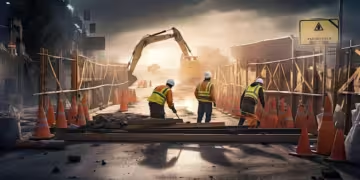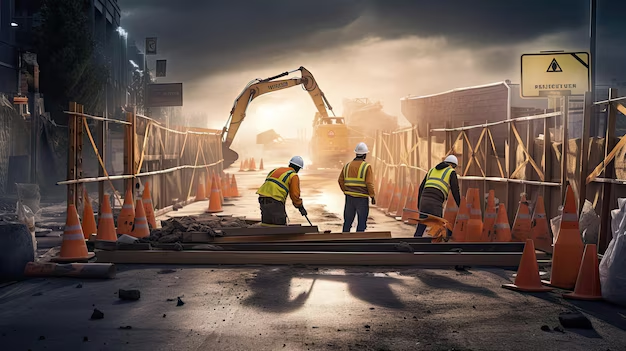Introduction to Scaffolding
As an experienced construction professional, I understand the critical role that scaffolding plays in enabling safe and efficient work at heights. Scaffolding is a temporary structure that provides workers with a stable and elevated platform to access areas that would otherwise be inaccessible or difficult to reach. Whether you’re working on a high-rise building, renovating a residential property, or maintaining industrial equipment, scaffolding is an essential tool that allows you to complete your tasks safely and effectively.
In this comprehensive guide, I’ll delve into the world of scaffolding, exploring the importance of safety, the different types of scaffolding systems, and the best practices for setup, inspection, and maintenance. By the end of this article, you’ll have a deeper understanding of how to maximize the efficiency and safety of your scaffolding operations.
The Importance of Scaffolding Safety
Safety is the top priority when it comes to scaffolding. Working at heights inherently carries risks, and it’s crucial to prioritize the well-being of your workers and the public. Improper setup, faulty equipment, or a lack of safety protocols can lead to catastrophic accidents, resulting in injuries, property damage, and legal liabilities.
As a responsible construction professional, I make it a point to emphasize the importance of scaffolding safety to my team. We thoroughly train our workers on the proper procedures for setting up, inspecting, and using scaffolding, ensuring that they are equipped with the knowledge and skills to work safely at heights. Additionally, we strictly adhere to all relevant safety regulations and industry best practices to minimize the risk of accidents.
By prioritizing scaffolding safety, not only do we protect our workers and the public, but we also enhance the overall efficiency of our operations. Accidents and downtime can significantly disrupt project timelines and budgets, so investing in safety measures ultimately pays dividends in the long run.
Understanding Different Types of Scaffolding
Scaffolding systems come in a variety of designs, each with its own unique features and applications. Understanding the different types of scaffolding is crucial for selecting the appropriate system for your project and ensuring that it is used correctly.
Here are some of the most common types of scaffolding:
- Supported Scaffolding: This is the most widely used type of scaffolding, consisting of a platform supported by rigid vertical members, such as poles or frames, that are secured to the ground or a building structure.
- Suspended Scaffolding: Also known as a “swing stage,” this type of scaffolding is suspended from overhead support structures, such as beams or trusses, allowing workers to access hard-to-reach areas.
- Cantilever Scaffolding: This system utilizes a projecting platform that extends beyond the base of support, providing access to areas that are difficult to reach with traditional scaffolding.
- Aerial Lifts: These mobile platforms, such as cherry pickers or scissor lifts, allow workers to elevate themselves to the desired height, making them a versatile option for small-scale projects or maintenance tasks.
- Mobile Scaffolding: Designed for easy movement, this type of scaffolding is mounted on wheels or casters, allowing it to be repositioned as needed during a project.
Each of these scaffolding systems has its own unique advantages and considerations, and it’s essential to carefully evaluate the specific requirements of your project to select the most appropriate solution.
Proper Setup and Inspection of Scaffolding
Proper setup and regular inspection of scaffolding are critical to ensuring the safety and stability of the system. Cutting corners or overlooking these essential steps can have serious consequences, putting workers and the public at risk.
When setting up scaffolding, we follow a comprehensive checklist to ensure that every step is completed correctly. This includes:
- Verifying the ground or surface is level and can support the weight of the scaffolding and workers.
- Properly securing the base of the scaffolding to prevent it from shifting or collapsing.
- Ensuring that all components, such as planks, guardrails, and braces, are in good condition and installed correctly.
- Checking that the scaffolding is plumb and level, with no gaps or uneven surfaces.
- Confirming that the load-bearing capacity of the scaffolding is sufficient for the intended use.
Regular inspections are also a crucial part of our scaffolding safety protocols. We conduct thorough inspections before each use, as well as daily and weekly checks, to identify any potential issues or damage. This includes:
- Visually inspecting all components for signs of wear, damage, or deterioration.
- Checking that the scaffolding is properly secured and stable.
- Ensuring that all safety features, such as guardrails and toe boards, are in place and functioning correctly.
- Verifying that the scaffolding is being used within its intended load limits and capacity.
By following these rigorous setup and inspection procedures, we can be confident that our scaffolding systems are safe and reliable, allowing our workers to perform their tasks efficiently and with peace of mind.
Essential Safety Equipment for Working on Scaffolding
Working on scaffolding requires the use of specialized safety equipment to protect workers from the risks associated with working at heights. As a responsible construction professional, I ensure that my team is equipped with the following essential safety gear:
- Hard Hats: Protecting the head from falling objects or potential impacts is crucial when working on scaffolding.
- Fall Arrest Systems: These include full-body harnesses, lanyards, and anchorage points to prevent workers from falling.
- Protective Footwear: Slip-resistant, steel-toed boots provide stability and protection for the feet.
- Gloves: Cut-resistant gloves help prevent hand injuries when handling scaffolding components.
- High-Visibility Clothing: Bright, reflective clothing ensures that workers are easily visible to others on the jobsite.
- Safety Goggles: Eye protection shields workers from dust, debris, and other hazards.
In addition to providing the necessary safety equipment, we also train our workers on the proper use and maintenance of these items. By ensuring that our team is equipped with the right gear and knows how to use it effectively, we can significantly reduce the risk of accidents and injuries on the job.
Tips for Maintaining Scaffolding
Proper maintenance is essential for ensuring the long-term safety and reliability of your scaffolding systems. Regular inspections and proactive maintenance can help extend the lifespan of your equipment and prevent costly downtime or accidents.
Here are some key tips for maintaining scaffolding:
- Inspect Components Regularly: Carefully inspect all scaffolding components, including planks, frames, braces, and connections, for signs of wear, damage, or deterioration.
- Clean and Lubricate Moving Parts: Keep moving parts, such as wheels or casters, clean and properly lubricated to ensure smooth operation.
- Store Scaffolding Properly: When not in use, store scaffolding components in a dry, secure location to prevent weathering and damage.
- Replace Worn or Damaged Parts: Immediately replace any worn, damaged, or defective components to maintain the structural integrity of the scaffolding.
- Follow Manufacturer’s Instructions: Adhere to the manufacturer’s guidelines for maintenance, inspection, and safe use of the scaffolding system.
- Keep Accurate Records: Maintain detailed records of all inspections, maintenance activities, and any repairs or replacements made to the scaffolding.
By implementing a comprehensive maintenance program, we can extend the lifespan of our scaffolding equipment, reduce the risk of accidents, and ensure that our workers have access to safe and reliable platforms for their work.
Maximizing Efficiency with Scaffolding
Scaffolding not only enhances safety but can also significantly improve the efficiency of construction and maintenance projects. By carefully planning and optimizing the use of scaffolding, we can streamline workflows, minimize downtime, and increase productivity.
Here are some strategies we employ to maximize the efficiency of our scaffolding operations:
- Modular Design: Investing in modular scaffolding systems that can be quickly assembled and reconfigured allows us to adapt to changing project requirements and work areas.
- Prefabrication: Preparing and pre-assembling certain scaffolding components off-site can reduce setup time and improve overall efficiency on the job.
- Integrated Access Solutions: Combining scaffolding with other access systems, such as aerial lifts or suspended platforms, can provide workers with a comprehensive and versatile solution for reaching elevated areas.
- Detailed Planning: Carefully planning the placement and configuration of scaffolding, taking into account factors like access, load-bearing requirements, and workflow, helps us optimize the use of space and minimize disruptions.
- Workforce Training: Ensuring that our workers are well-trained in the proper use and maintenance of scaffolding systems helps to improve productivity and reduce the risk of errors or delays.
By implementing these efficiency-enhancing strategies, we are able to complete our projects more quickly, reduce labor costs, and deliver higher-quality results for our clients.
Common Mistakes to Avoid when Working with Scaffolding
Despite the importance of scaffolding safety and efficiency, there are still common mistakes that can occur on construction sites. By being aware of these pitfalls and taking proactive measures to address them, we can maintain a safe and productive work environment.
Some of the most common mistakes to avoid include:
- Improper Setup or Inspection: Failing to follow the proper procedures for setting up and inspecting scaffolding can lead to instability, collapse, or other serious safety issues.
- Overloading: Exceeding the weight capacity of the scaffolding system can compromise its structural integrity and put workers at risk.
- Lack of Fall Protection: Neglecting to provide workers with the necessary fall arrest systems and other safety equipment can expose them to the dangers of working at heights.
- Inadequate Training: Allowing untrained or inexperienced workers to use scaffolding can result in accidents, improper use, and decreased efficiency.
- Poor Maintenance: Failing to properly maintain and inspect scaffolding components can lead to wear, damage, and potential failure.
- Disregarding Site Conditions: Not considering factors like uneven ground, overhead obstructions, or environmental hazards can compromise the safety and stability of the scaffolding system.
By being vigilant and proactive in addressing these common mistakes, we can create a safer and more efficient work environment for our team and ensure the successful completion of our projects.
Training and Certification for Scaffolding
Proper training and certification are essential for ensuring the safe and effective use of scaffolding on construction sites. As an experienced construction professional, I understand the importance of investing in the ongoing education and development of our workforce.
All of our workers who are responsible for setting up, inspecting, or using scaffolding systems are required to undergo comprehensive training and certification programs. These programs cover a wide range of topics, including:
- Scaffolding Regulations and Standards: Ensuring our workers are up-to-date on the latest safety regulations and industry best practices.
- Scaffolding Types and Applications: Educating our team on the different types of scaffolding systems and their appropriate uses.
- Proper Setup and Inspection Procedures: Providing hands-on training on the correct methods for setting up and inspecting scaffolding.
- Fall Protection and Safety Equipment: Ensuring our workers are proficient in the use of personal protective equipment and fall arrest systems.
- Maintenance and Troubleshooting: Equipping our team with the knowledge to properly maintain and address any issues with the scaffolding.
- Site-Specific Considerations: Addressing the unique challenges and requirements of the specific job site or project.
By investing in comprehensive training and certification programs, we can be confident that our workers have the necessary knowledge and skills to safely and efficiently use scaffolding, minimizing the risk of accidents and enhancing the overall productivity of our operations.
Conclusion: The Key to Safe and Efficient Scaffolding
Scaffolding is an essential tool in the construction industry, enabling workers to safely access and complete tasks at heights. As an experienced construction professional, I have witnessed the critical role that scaffolding plays in ensuring the success and safety of our projects.
Throughout this guide, we have explored the importance of scaffolding safety, the different types of scaffolding systems, the proper procedures for setup and inspection, the essential safety equipment, and the strategies for maximizing efficiency. We have also discussed the common mistakes to avoid and the importance of training and certification for our workers.
By following these best practices and prioritizing safety and efficiency, we can create a work environment that is both productive and secure. Investing in the right scaffolding solutions and empowering our team with the necessary knowledge and skills can lead to significant benefits, including reduced downtime, improved project timelines, and, most importantly, the protection of our workers and the public.
If you’re looking to optimize your scaffolding operations and ensure the safety and efficiency of your construction projects, I encourage you to reach out to our team of experts. We can provide personalized guidance, training, and solutions to help you achieve your goals. Contact us today to learn more.
ScaffMag is a leading magazine dedicated to providing the latest news, trends, and insights from the global scaffolding industry. Our mission is to provide valuable information to scaffolding professionals, including scaffolders, contractors, and engineers, as well as anyone who is interested in the world of scaffolding.

















































